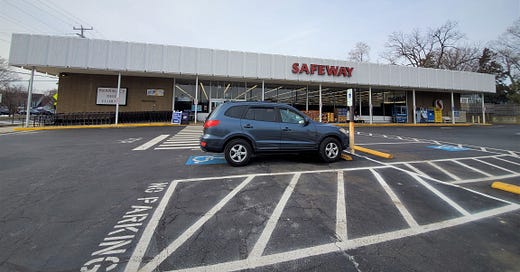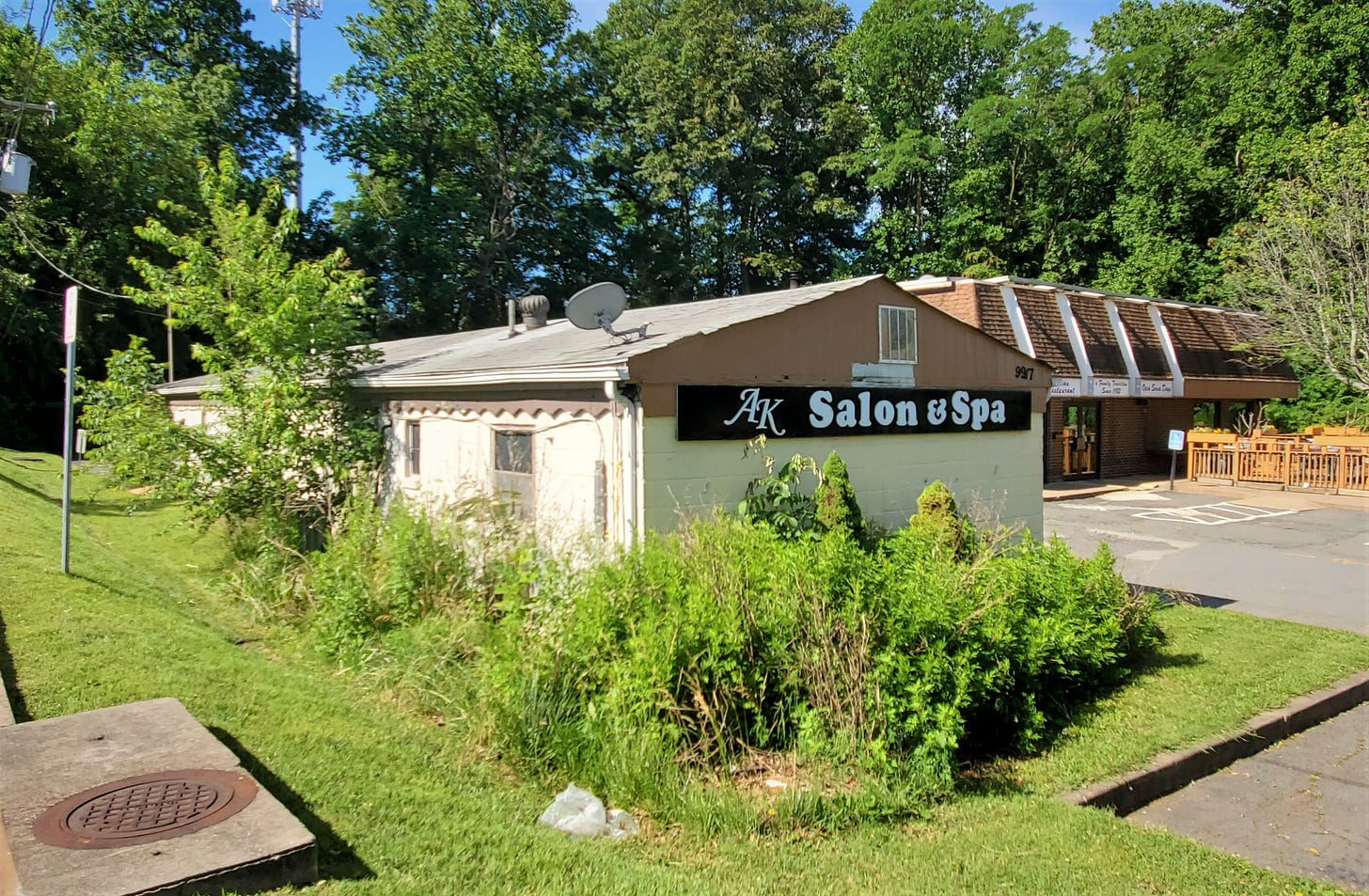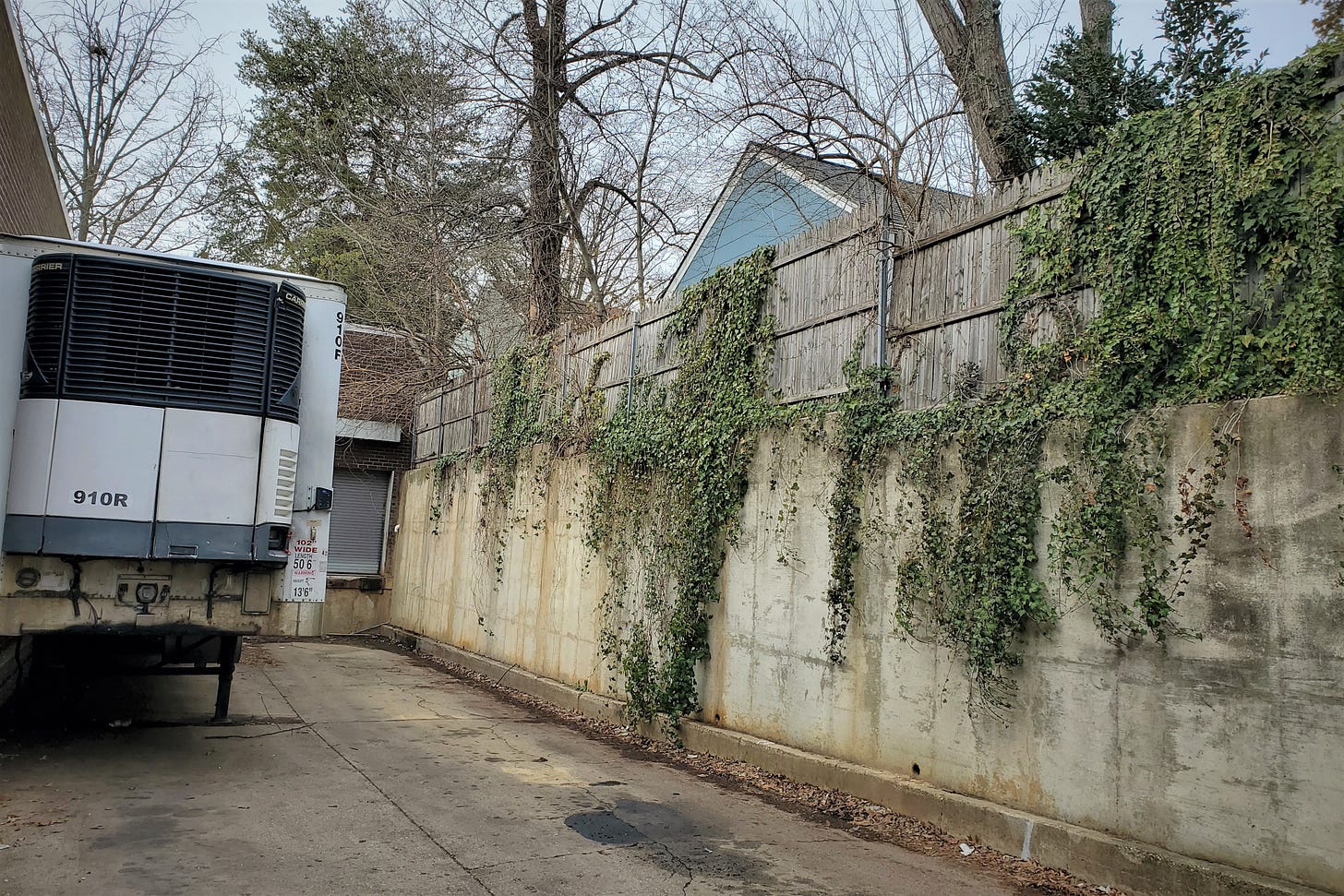A couple of weeks ago, I drove out to the Ballston area of Arlington County, Virginia, to check out an old Safeway supermarket. A pretty standard workday for me. I’d heard that they were planning a major interior renovation, and so I wanted to see what it looked like in its older incarnation. (I’d seen this bit of local news from a fellow who runs a pro-housing group in Northern Virginia, with a focus on Arlington and Alexandria —if you happen to live there, check it out.)
The Safeway seems to have been built in the same era as the “Marina” building type Safeway used in the 1960s, which featured a soaring, wood-paneled barrel-vault ceiling. (I featured one in last week’s “What Do You Think You’re Looking At?” piece.) Based on old aerial imagery, it’s from the late 1960s or early 1970s. In any case, it’s on the old side, and it doesn’t look like it’s ever been remodeled. Take a look. It actually looks like a first-generation suburban big-box store, even though it’s a little newer than that.
Aside from the retro styling—it reminds me of drawings of supermarkets from midcentury children’s books, especially the almost all-glass front—there are a few things about this store that stand out to me. In general, it manages to be a box store (though on the smaller side) in a fairly urban context. And it kind of works.
For example, look at the sidewalk along the side of the building. Instead of being surrounded by asphalt, the building faces a relatively small parking lot, and backs up right to the edge of the sidewalk. (They put the entrance at a right angle to the street so that store traffic wouldn’t interfere with pedestrian traffic, presumably.) The lack of a setback here allows the store to form a street wall rather than a big gap, where a pedestrian is surrounded on both sides by cars.
Here are two views from the sidewalk:
When I turned right at the next intersection, I saw this. There’s a small, informal space between the sidewalk and the building here. It basically serves as a little outdoor break area. I don’t know if I’ve ever seen a tree this close to a box store!
Here’ a closeup of the corner at the top left. It’s nearly possible to walk right up to the building and climb onto its roof! It’s amazing to me how accessible this big structure is, how it’s kind of just casually there. It doesn’t dominate the surrounding space, in a way that subtly communicates that you’re not supposed to be there unless you’re shopping.
I’ve noticed this phenomenon of what you could call human-scaled suburban commercial architecture before. Take a look at this former motel on U.S. 50 in Fairfax, which is now a tiny strip mall. It’s so small, and it alters the land around it very little.
Or this old auto garage along the same commercial strip, which is nestled into an area between the road and a retaining wall built for an old trolley line.
But back to the Safeway. The next right turn was onto a residential street. Behind one of the houses, I could see the Safeway building. Was it an urgent matter to separate residential from retail, and make sure nobody could access the latter without a car? Obviously not. Is it terrible to be able to see a supermarket from your back yard? Not really.
And here’s that same backyard garage and side of the supermarket from the other side. I’m standing in the truck bay, and at the top right is that garage. That house’s back yard ends at the fence, which blocks the drop-off into the truck bay area!
These are the kinds of little quirks and minor inconveniences that arise when suburban-style development adapts itself a little bit to a more traditional pattern. In exchange for that, we get a much more walkable and convenient built environment, with less overbuilt awkward spaces and less infrastructure to maintain over time.
Here’s the satellite view:
In other words, the way we build big-box stores is the issue, not the idea of large stores shaped like boxes. That’s just…a store. But they can use up a lot more land and infrastructure than this, and fail to interface in any way with their surroundings. Or, they can humble themselves a little bit, and nestle into a fairly urban landscape without causing much trouble at all.
Related Reading:
Please consider upgrading to a paid subscription to help support this newsletter. You’ll get a weekend subscribers-only post, plus full access to the archive of over 200 posts and growing. And you’ll help ensure more material like this!














Been to that one probably a hundred times back in the early aughts. It's amazing it has survived.
This oddly enough resembles a lot of the places where I'm at (Stamford CT). The unifying factor I guess is being an old well-established satellite city of a larger metro.